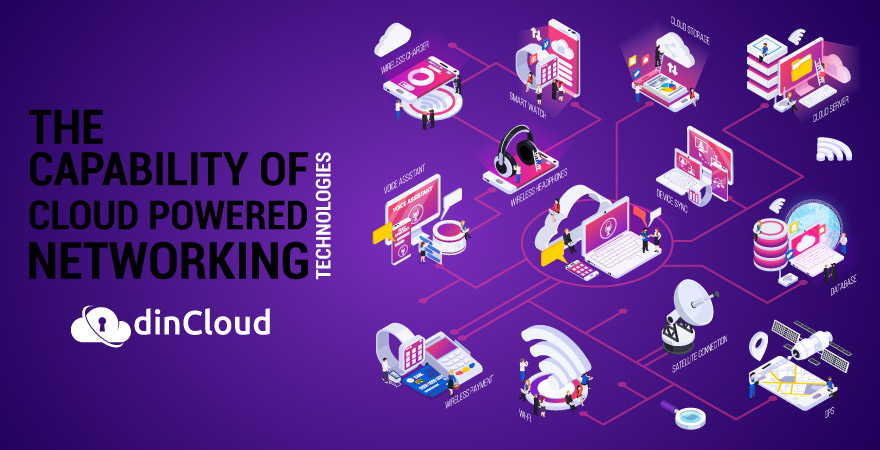With the ever-increasing influence of cloud based solutions on the modern workplace, many other facets of the organization also need to evolve. A very pivotal element of the organization in this regard is network architecture. The traditional approach to network evolution is no longer effective.

The traditional approach was characterized by making small, incremental changes as and when the needs of the organization exhibited an uptick. With cloud based solutions becoming more mainstream, a well thought out plan for the network orchestration will also be required.
In this post, we will outline some of the leading network technologies that are gaining a lot of traction because they are driven by the cloud.
Cloud Managed Networks – CMN
With more enterprise data moving over to the cloud, the management needs of the network also tend to grow exponentially. CMNs provide a cloud-based portal or interface through which the entire connectivity needs of the organization, both wired and wireless, can be managed centrally.

This centralized connectivity that comes in the form of CMNs complements the inherent flexibility of the cloud-based solution. The initial adopters of this technology were small to mid-sized organizations with a relatively smaller IT workforce and limited networking needs, but this trend is changing to include bigger entities as well.
Also Read:
- Top 11 Guidelines for Cloud Security in 2020
- 8 Reasons: Why Cloud Computing for Small Business?
- Difference Between Cloud Computing & Fog Computing
The major beneficiaries of CMNs can be organizations that have a limited IT staff. Another obvious limiting factor is monetary constraints, which tend to limit the number of viable options. This networking model is ideal for organizations that have dispersed operations or branches, but lack the human and financial capital.
CMNs enable such smaller or financially constrained organizations to manage their remote sites by maintaining connectivity and troubleshooting most bottlenecks over the secure remote network. However, the cost to benefits equation does not look that good for bigger enterprises, with a large number of branches.
In the case of large organizations, a more in-depth analysis of the existing organizational infrastructure is required and how it would seamlessly integrate with the CMN capability. Another limiting factor would be ongoing subscription arrangements that may entail high switching costs.
Service Mesh
You can consider the service mesh as an ecosystem that provides the right enabling environment for service level communication. As the trend of both hybrid and multi cloud deployments picks up pace, it results in a new set of challenges to integrate many individual services into a cohesive whole.
Some of the most critical services in this regard include load balancing, request routing, encryption and authorization . A service mesh network architecture is ideal for deployment scenarios where the nature of operations involves mini or micro level services, but ones that may need to interact with each other too.
The concept of service mesh otherwise works very well with the way present cloud native software solutions are being developed. To better serve the needs of a rapidly growing cloud market, software solutions are being offered in the form of much smaller clusters or containers.
The role of service mesh networking becomes pivotal in situations where organizations aim to gel a disparate set of small apps or processes to effectively serve organizational goals. The previously employed solutions such as Application Programming Interface (API), load balancer or Application Delivery Controller (ADC) are too heavy.
ADCs or APIs also perform the same function as the one now being taken over by service mesh but the latter is far lighter and thus, much more agile. The nimble footprint of service mesh architecture has made it the go to solution for organizations that are delivering cloud based micro services.
Within the service mesh network architecture, organizations have the option to deploy ready made service mesh solutions developed over custom platforms. This reduces both development time and cost, which in turn optimizes the deployment cycle.
However, in cases where either the complexity of the micro service is high or the number of such services to integrate is higher, organizations tend to pursue indigenous development of a service mesh. Although time and resource intensive, this strategy pays more rewards over the mid to long term horizon.
Also Read:
- 3 Things Every Small Business Can Do With Hybrid BPM and RPA
- 10 Factors to Consider Before Migrating to the Hybrid Cloud
Kubernetes Networking
Without doubt, Kubernetes has established itself as a highly effective application management solution over the cloud. However, with multi cloud deployments becoming the norm rather than exception, the need for an effective Kubernetes networking mechanism arises.
The addition of Kubernetes Networking to the mix amplifies the functionality and effectiveness of this tool as it equips containers to interact with the apps within a container as well as outbound communications. Internal coms are enabled by Container Network Interface (CNI) plugins.
The container interacts with external sources through an ingress controller. As the public Cloud Service Providers (CSP) cater to a wide range of customers, they have simplified this process by offering ready to use CNI plugins and ingress controllers.
However, in the case of in house or on premise solutions, there may be a more pressing need for customized or third party CNI plugins and ingress controllers to better cope with the customized hardware. A word of caution though, given the rapidly evolving Kubernetes networking, avoid committing to long term arrangements.
Conclusion
In order to truly capitalize from cloud-based solutions, most organizations will have to undertake a major assessment and realignment of their existing network architectures. The traditional, incremental approach to network development won’t be adequate anymore and a major network revamp may be the right answer.


